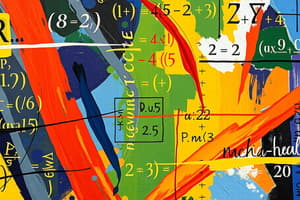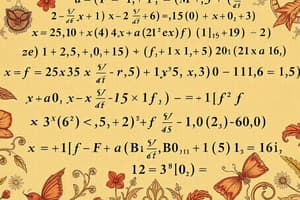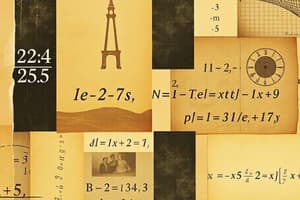Podcast
Questions and Answers
What is the purpose of using inverse operations in solving equations?
What is the purpose of using inverse operations in solving equations?
- To introduce new variables
- To simplify the equation
- To change the equation's degree
- To cancel out terms or isolate the variable (correct)
How can you ensure that a solution found for an equation is correct?
How can you ensure that a solution found for an equation is correct?
- By factoring the equation again
- By rewriting the equation
- By graphing the equation
- By substituting the found value in the original equation (correct)
What distinguishes quadratic equations from linear equations?
What distinguishes quadratic equations from linear equations?
- Linear equations involve variables only to the first power (correct)
- Linear equations involve variables raised to the second power
- Quadratic equations are always simpler than linear equations
- Quadratic equations cannot be graphed
What is the primary purpose of algebra?
What is the primary purpose of algebra?
Which method is NOT commonly used to solve quadratic equations?
Which method is NOT commonly used to solve quadratic equations?
Which of the following best describes a variable in algebra?
Which of the following best describes a variable in algebra?
What is a key characteristic of polynomials?
What is a key characteristic of polynomials?
What happens when you graph a linear equation in two variables?
What happens when you graph a linear equation in two variables?
What is the role of constants in algebra?
What is the role of constants in algebra?
What is the importance of finding roots in quadratic equations?
What is the importance of finding roots in quadratic equations?
Which of the following operations is defined for all numbers?
Which of the following operations is defined for all numbers?
What does the commutative property state?
What does the commutative property state?
Which method is NOT typically used to solve a system of equations?
Which method is NOT typically used to solve a system of equations?
What is the process of isolating the variable in an equation?
What is the process of isolating the variable in an equation?
Which of the following best defines an equation?
Which of the following best defines an equation?
What does the inverse property of addition state?
What does the inverse property of addition state?
Flashcards
Algebra
Algebra
A branch of mathematics using symbols to represent numbers and mathematical objects.
Variable
Variable
A symbol (like x or y) that represents an unknown quantity.
Constant
Constant
A symbol representing a fixed value (number).
Expression
Expression
Signup and view all the flashcards
Equation
Equation
Signup and view all the flashcards
Addition
Addition
Signup and view all the flashcards
Solving Equations
Solving Equations
Signup and view all the flashcards
Distributive Property
Distributive Property
Signup and view all the flashcards
Inverse Operations
Inverse Operations
Signup and view all the flashcards
Linear Equations
Linear Equations
Signup and view all the flashcards
Quadratic Equations
Quadratic Equations
Signup and view all the flashcards
Simplifying Expressions
Simplifying Expressions
Signup and view all the flashcards
Combining Like Terms
Combining Like Terms
Signup and view all the flashcards
Factoring Expressions
Factoring Expressions
Signup and view all the flashcards
Solving Linear Equations
Solving Linear Equations
Signup and view all the flashcards
Checking Solutions
Checking Solutions
Signup and view all the flashcards
Study Notes
Introduction to Aldgebra
- Algebra is a branch of mathematics that uses symbols to represent numbers and other mathematical objects.
- It provides a generalized framework for solving mathematical problems.
- It uses variables, constants, equations, expressions, and inequality to represent various mathematical relationships and patterns.
- Algebra enables the formulation and solution of problems from various fields including science, engineering, and economics.
Basic Concepts in Algebra
- Variables: Symbols (usually letters like x, y, z) that represent unknown quantities.
- Constants: Symbols that represent fixed numerical values.
- Expressions: Combinations of variables, constants, and mathematical operations (like addition, subtraction, multiplication, division).
- Equations: Statements that show the equality between two expressions.
- Inequalities: Relationships that show that one expression is greater than, less than, or equal to another expression.
Fundamental Operations in Algebra
- Addition: Combining quantities, typically represented by '+' sign.
- Subtraction: Removing a quantity, typically represented by '-' sign.
- Multiplication: Repeating addition, typically represented by '*' symbol or juxtaposition (e.g., 2x).
- Division: Splitting a quantity into equal parts in proportion to a quantity, typically represented by '/' symbol.
- Division by zero is undefined.
Properties of Operations
- Commutative property: Changing the order of numbers in addition or multiplication does not affect the result.
- Associative property: Grouping numbers in addition or multiplication does not affect the result.
- Distributive property: Multiplying a sum by a number is the same as multiplying each addend by the number and then adding the products.
- Identity property: Adding zero to a number results in the same number. Multiplying a number by 1 results in the same number.
- Inverse property: Adding a number's opposite results in zero. Multiplying a number by its reciprocal results in one.
- Properties of zero: Multiplication of any number by zero equals zero.
Solving Equations
- Isolating the variable: The central process to finding the value of the variable in an equation. Techniques include performing operations on both sides of the equation to eliminate constants and coefficients.
- Using inverse operations: The process of performing the opposite operation to cancel out terms or to isolate the variable.
- Checking solutions: Substituting the found value in the original equation to ensure that it satisfies the equation.
- Solving Linear Equations: These equations involve only variables to the first power.
- Solving Quadratic Equations: These equations involve variables raised to the second power. Common methods include factoring, completing the square, and the quadratic formula
Algebraic Expressions and Simplification
- Simplifying expressions: Combining like terms, applying the distributive property, and performing other operations to make the expression as compact as possible.
- Combining like terms: Adding or subtracting terms with the same variables and exponents.
- Expanding expressions: Removing parentheses using the distributive property.
- Factoring expressions: The reverse of expanding, finding terms that can be factored out.
Polynomials
- Expressions containing variables and constants of non-negative integer exponents.
- Types of polynomials: Monomials (one term), binomials (two terms), trinomials (three terms), and polynomials of higher degrees.
- Basic operations with polynomials include addition, subtraction, multiplication and division.
- Polynomial operations are crucial for modeling various phenomena and solving mathematical problems involving multiple variables and their relationships.
Linear Equations in Two Variables
- Representing relationships between two quantities.
- Graphing equations on a coordinate plane yields straight lines.
- Solutions to linear equations are points on the line.
- Applications involve describing proportions, ratios, and growth rates within various fields.
Quadratic Equations and Graphs
- Dealing with equations that have a variable raised to the second power, called quadratic equations.
- Graphs result in parabolas.
- Finding roots (solutions) is significant for intersections of parabolas and other functions or lines.
System of Equations
- Multiple equations describing a shared solution (or intersection point) between functions.
- Solving systems of equations involves methods like substitution, elimination, and graphical approach, depending on the complexity of the problem.
Studying That Suits You
Use AI to generate personalized quizzes and flashcards to suit your learning preferences.




